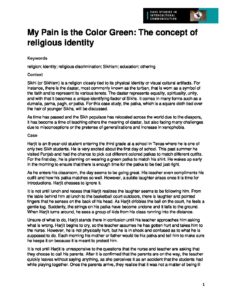My Pain is the Color Green: The concept of religious identity
Keywords
religion; identity; religious discrimination; Sikhism; education; othering
Context
Sikhi (or Sikhism) is a religion closely tied to its physical identity or visual cultural artifacts. For instance, there is the dastar, most commonly known as the turban, that is worn as a symbol of the faith and to represent its various tenets. The dastar represents equality, spirituality, unity, and with that it becomes a unique identifying factor of Sikhs. It comes in many forms such as a dumalla, parna, pagh, or patka. For this case study, the patka, which is a square cloth tied over the hair of younger Sikhs, will be discussed.
As time has passed and the Sikh populace has relocated across the world due to the diaspora, it has become a time of teaching others the meaning of dastar, but also facing many challenges due to misconceptions or the pretense of generalizations and increase in xenophobia.
Case
Harjit is an 8-year-old student entering the third grade at a school in Texas where he is one of only two Sikh students. He is very excited about the first day of school. This past summer he visited Punjab and had the chance to pick out different colored patkas to match different outfits. For the first day, he is planning on wearing a green patka to match his shirt. He wakes up early in the morning to ensure that there is enough time for the patka to be tied just right.
As he enters his classroom, the day seems to be going great. His teacher even compliments his outfit and how his patka matches so well. However, a subtle laughter arises once it is time for introductions. Harjit chooses to ignore it.
It is not until lunch and recess that Harjit realizes the laughter seems to be following him. From the table behind him at lunch to the basketball court outdoors, there is laughter and pointed fingers that he senses on the back of his head. As Harjit dribbles the ball on the court, he feels a gentle tug. Suddenly, the strings on his patka have become undone and it falls to the ground. When Harjit turns around, he sees a group of kids from his class running into the distance.
Unsure of what to do, Harjit stands there in confusion until his teacher approaches him asking what is wrong. Harjit begins to cry, so the teacher assumes he has gotten hurt and takes him to the nurse. However, he is not physically hurt, but he is in shock and confused as to what he is supposed to do. Each morning his mother or father would tie his patka and tell him to make sure he keeps it on because it is meant to protect him.
It is not until Harjit is unresponsive to the questions that the nurse and teacher are asking that they choose to call his parents. After it is confirmed that the parents are on the way, the teacher quickly leaves without saying anything, as she perceives it as an accident that the students had while playing together. Once the parents arrive, they realize that it was not a matter of being ill or physically hurt, but one of Harjit not understanding why someone removed a part of who he was.
Discussion Questions
As you consider this case, discuss:
- Why was Harjit in shock when his patka was removed?
- Why were the kids were inclined to remove the patka?
- In what ways do you see Harjit being Othered?
- What are Harjit’s parents teaching him by telling him not to remove his patka?
- If you were the teacher or the parents, what would you do?
- How does religious identity become vulnerable when isolated?
- Given the importance and history of the dastar, in this case specifically the patka, what larger issue(s) does this case shed light on?
- How can individuals, communities, and organizations be more educated and welcoming of religious diversity?
Additional Resources
Additional recommended resources to explore the central themes in this case are available.
- Klein, W. (2015). Responding to bullying: Language socialization and religious identification in classes for Sikh youth. Journal of Language, Identity & Education, 14(1), 19-35. https://doi.org/10.1080/15348458.2015.988568
- Gohil, N. S., & Sidhu, D. S. (2007). The Sikh turban: post-911 challenges to this article of faith. Rutgers JL & Religion. 1-60. https://lawandreligion.com/sites/law-religion/files/Sikh-Turban-Sidhu.pdf
- Ahluwalia, M. K., Nadrich, T., & Ahluwalia, I. S. (2019). Sikh Youth Coming of Age: Reflections on the Decision to Tie a Turban. Counseling and Values, 64(1), 20-34. https://doi.org/10.1002/cvj.12092
- Dhillon, K. P. (2011). Covering Turbans and Beards: Title VII’s Role in Legitimizing Religious Discrimination Against Sikhs. Cal. Interdisc. LJ, 215-252. https://gould.usc.edu/why/students/orgs/ilj/assets/docs/21-1%20Dhillon.pdf
Corresponding Author
Kaur, Upneet. American University, Washington, D.C., United States. Email: uk5768a@american.edu


